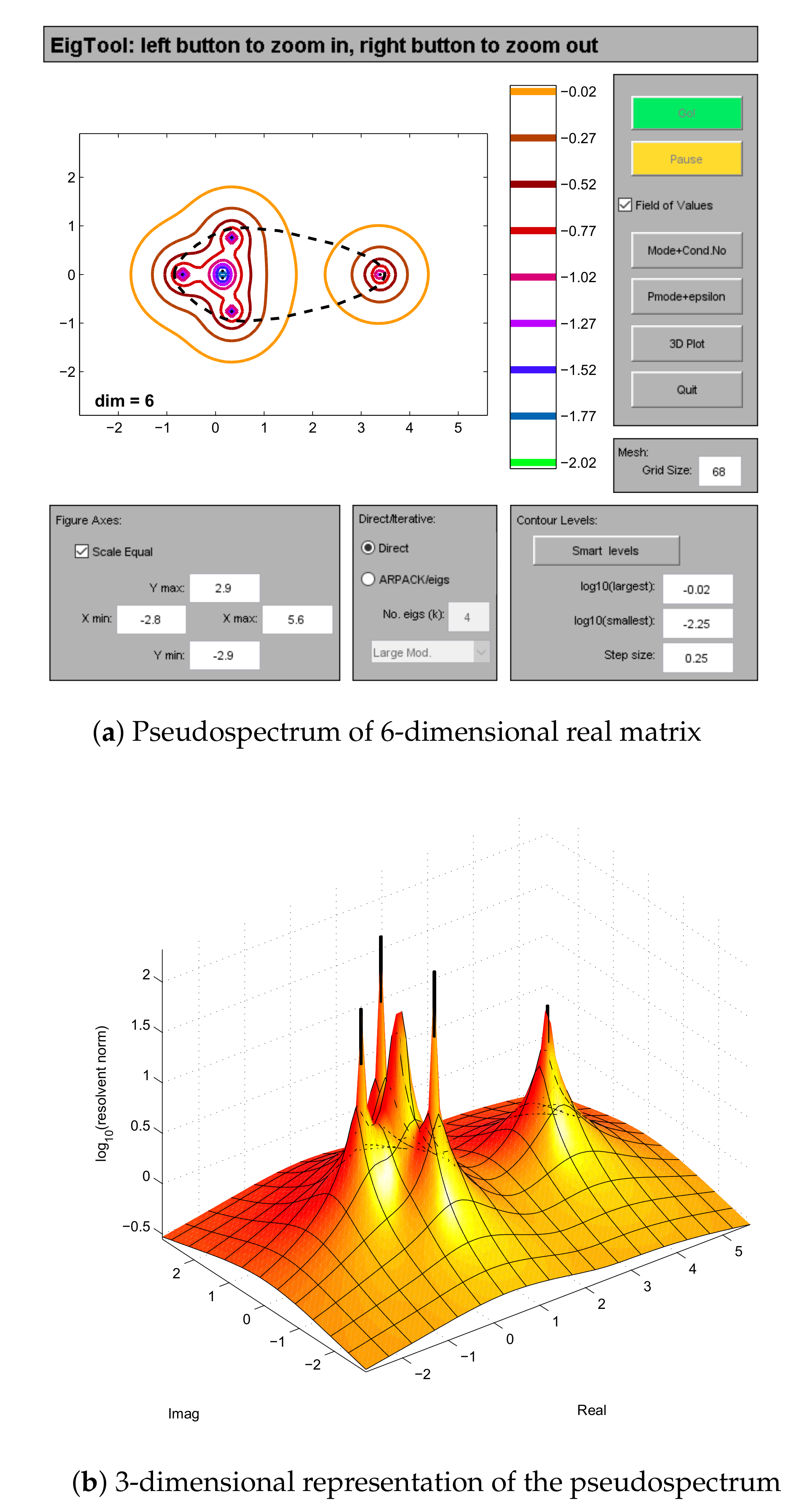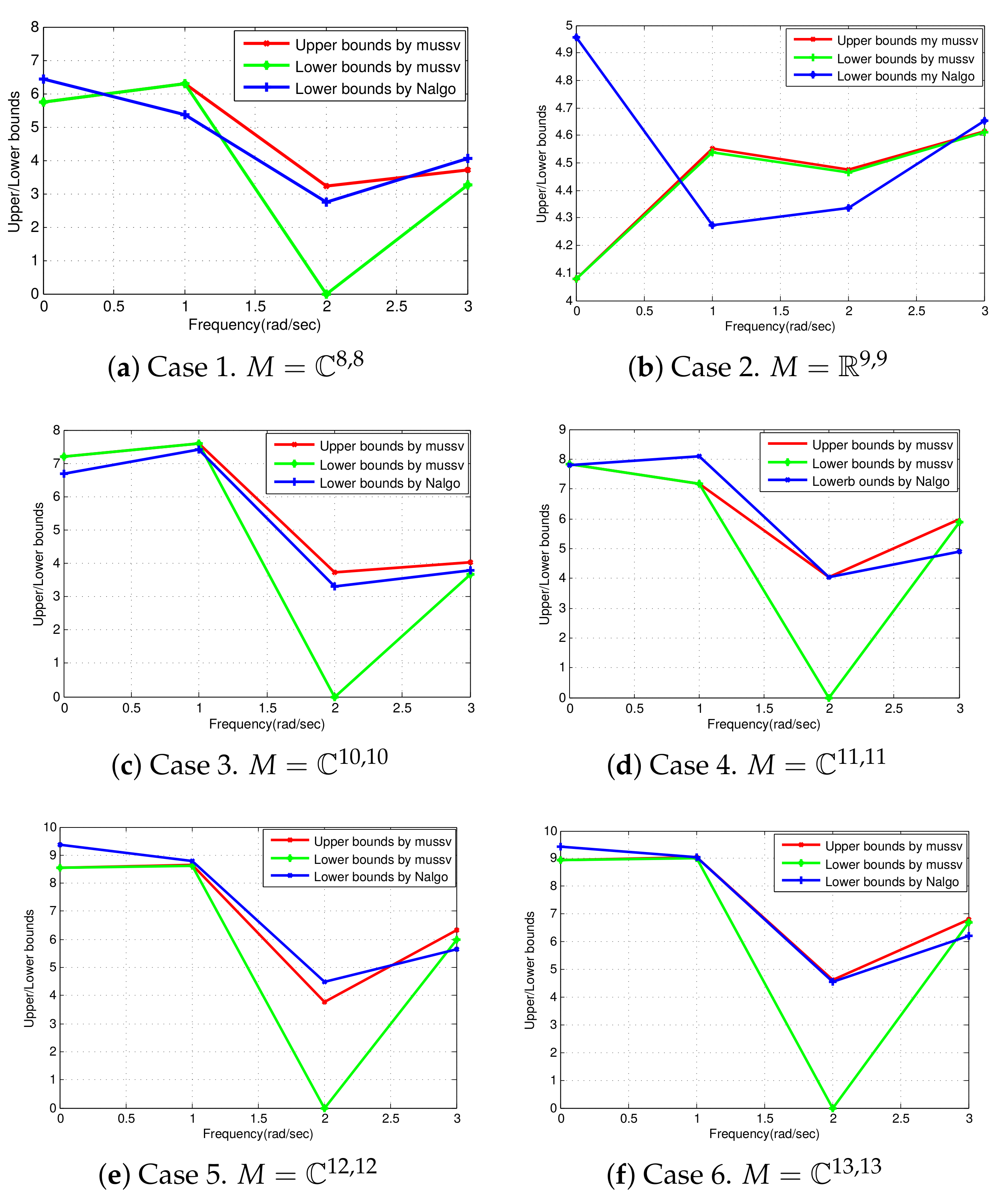1. Introduction
In system theory,
-value known as structured singular value (SSV) is a well-defined tool, first introduced by Doyle [
1]. It is used to analyze the robustness of linear feedback systems when they are subject to uncertainties, particularly structured uncertainties. The
-value tool has vast applications in control engineering, for instance, for the analysis of controller of an unstable system, the MIMO margins by using
and for the space shuttle robustness analysis [
2]. For more applications, we refer [
3,
4] and the references therein.
The numerical approximation of SSV appears as NP-hard problem [
5,
6]. The computation of the upper bounds of
-values is a hard problem; in fact, the NP-hard is in nature when only real uncertainties appear [
7].
The power method [
3,
8] is used to approximate the lower bounds of
-values when only pure complex uncertainties are under consideration. This is a seemingly robust numerical method due to the fact that it depends solely on matrix-vector products. The power method is easy to apply only when mixed real perturbations and complex perturbations are taken into account [
9,
10,
11]. This method resembles a mixture of power techniques used for the computation of eigenvalues and singular values of the constant matrices. This method also prove that
-values act as an equilibrium point of the power technique. The power method fails to numerically compute the lower bounds of
-values only when pure real uncertainties are under discussion. We refer to [
12,
13,
14,
15,
16,
17,
18,
19,
20] and references therein for a comprehensive study of the numerical algorithms to compute numerically the bounds of
-values from below.
An approximation of bounds of
-values involve fundamental difficulties when one considers pure real uncertainties because the real
-values might be discontinuous function of the given problem data [
21,
22]. Thus the available algorithms [
13,
14,
15,
19] to deal such problems have a computational cost which has exponential growth in nature. The idea of regularization to such a problem helps to reduce computational cost by making use of the mixed real/complex power iteration.
In this article, we use an iterative method [
23] in order to numerically compute the
-values bounds from below for a set of constant matrices generated randomly. The idea is based on a two level algorithm described in a great detail in [
23]. The inner algorithm provides basis to develop a gradient system of ordinary differential equations (ODEs) and eventually solves this system by making use of extremizers of structured spectral-value sets. On the other hand, The outer algorithm helps to adjust the small positive parameter which acts as valid perturbation
, when making use of fast Newton’s iteration.
This paper is organized as follows: In
Section 2 we provide the basic definitions of pseudo-spectra and structured singular values. In
Section 3 we give the reformulation of the definition of structured singular values.
Section 4 of this article contains the computation of pseudo-spectra, where in
Section 5 we explain how the computation of structured singular values can be addressed by making use of an inner-outer algorithm. In the outer algorithm, we determine a small perturbation level
while in inner algorithm we determines a local extremizer of the structured spectral value set.
Section 6 refers to numerical experiments to compare the lower bounds of SSV obtained with algorithm [
23] to those obtained with MATLAB function mussv.
Section 7 summarizes our conclusions.
5. Proposed Methodology
In this section, the main objective is to discuss the optimization problem as mentioned in Definition
11, we make use of a numerical approach which is based on low-ranked ordinary differential equations. The numerical method is composed of a two-level algorithm, the inner algorithm and an outer algorithm. In this Section, we first discuss the inner-algorithm which shows how to give a theoretical construction to the system of ordinary differential equations. Secondly, we discuss how to deal with such systems mathematically. Next, we discuss the outer algorithm, which helps to modify the small positive real parameter
. The outer algorithm is based on Newton’s iteration for approximating the roots of non-linear equations. The outer-algorithm computes an exact derivative of an extremizer say,
for
and
. Complete details of the numerical method under consideration are given in [
23,
24]. Finally, we discuss the computation of an extremizer. For this purpose, we approximate the derivative of an eigenvalue matrix
of a smooth matrix family say
for some fixed parameter
p.
5.1. Inner-Algorithm
5.1.1. The Basic Theory
Consider some smooth matrix family
for a small parameter p. Let
and
be the eigenvalue and eigenvector matrices corresponding to
. In matrix form
In Equation (
12), computation of eigenvector matrix
is not unique unless all of the eigenvectors remain fixed. For distinct eigenvalues all of the eigenvectors are computed up to a constant multiplier.
The theory of computing is extended if eigenvalue derivatives are repeated while the second order derivatives of eigenvalues remain distinct. This theory is further generalized to complex-valued and Hermitian matrix.
Here and hereafter the symbol
denotes the derivative while we write
, that is, we omit the dependency on p. By differentiating Equation (
12) we get,
or
Our goal is to determine
, the derivative of eigenvalues matrix. For this purpose, we multiply Equation (
13) with
throughout to have,
Since
, this implies:
let
, we find
thus Equation (
14) gives:
or
Therefore,
Finally, this gives the required result for the computation of the derivative of spectrum of matrix valued function
as follows
5.1.2. Approximation of Extremizers
A matrix valued function having the largest eigenvalue bounded above by 1 and the matrix valued function having a smallest eigenvalue which minimizes the modulus of structured spectral value set, is known as an extremizer. The following theorem computes an extremizer for a chosen smallest complex number belonging to the set .
Theorem 1 ([
23])
. For a perturbation having the block diagonal structurewith acts as a local extremizer of structured spectral value set. For a simple smallest eigenvalue of matrix valued function having right and left eigenvetors x and y scaled as and let . The non-degeneracy conditionshold. Then magnitude of each complex scalarappears to be exactly equal to 1 while each full block possesses a unit 2-norm.
Proof. For proof we refer to [
23]. □
5.1.3. Gradient System of ODEs
The gradient system of ODEs for an admissible perturbation
to approximate a local extremizer of smallest eigenvalue
, is obtained as,
where
for
and
is a characteristic function. For a further discussion on the construction of gradient system of ODEs in above equations, we refer to [
23].
5.2. Outer-Algorithm
In an outer-algorithm the main aim is to vary , the perturbation level, by means of a fast Newton’s iteration. In turn, will provide the approximation of lower bound of μ-value.
We make use of fast Newton’s iteration in order to solve a problem
In order to solve Equation (
16), we need to compute
the derivative.
The following Theorem 2 helps us to compute , when is simple and , are assumed to remains smooth in the neighboring region of perturbation level .
Theorem 2 ([
23])
. Consider matrix valued function . Let x and y as a function of perturbation level acts as right and left eigenvectors of matrix valued function . Consider the scaling of these vector accordingly to Theorem 1. Let and assume that non-degenracy conclusions as discussed in Theorem 1 yield then Proof. For proof we refer to [
23]. □
Remark 1. Choice of suitable initial value matrix and initial perturbation level: For a suitable choice of the initial value matrix and an initial perturbation level , we refer to [23]. 6. Numerical Computation
In this section, we present numerical results for both lower and upper bounds of μ-values for randomly generated matrices in MATLAB (R2018a, MathWorks, Natick, MA, USA). The numerical computation of the lower bounds of structured singular values with the help of Nalgo, show the tighter results for the μ-values lower bounds computed by means of well-known MATLAB routine mussv. In each experiment the admissible uncertainties ∇ and E are computed with the help of mussv and Nalgo [
23] respectively.
Example 1. First we consider a six dimensional real valued matrix MWe choose block uncertainties The admissible uncertainty ∇ is given as belowwith The main drawback with mussv is that it does not compute the unit 2-norm of each block of admissible perturbation Δ and by this way it loose the optimality condition. The optimality condition requires that: not only the admissible perturbation Δ should possess unit 2-norm but each of its block also possesses a unit 2-norm. The approximated lower bound of μ-value is . Moreover, by using the algorithm [23], the admissible perturbation E is obtained aswith The algorithm [23] computes the unit 2-norm of admissible perturbation E. It does not violate the optimality condition and hence computes the unit 2-norm against each block of E. The lower bound approximation is which is a much better approximation than the one computed numerically. If instead of full complex blocks, one chose the uncertainties to be repeated as complex blocks, then the mussv routine will not compute the desired admissible perturbations such that each repeated complex block possesses a unit 2-norm. On the hand, Nalgo computes each repeated complex block in such a way that not only the admissible perturbation possesses a unit 2-norm but each individual block also has a largest singular value to be exactly equal to 1.
In
Table 1, we present the comparison for the lower and upper bounds of μ-value approximated numerically with the help of mussv and an efficient numerical algorithm [
23] for matrix M in Example 1. The first column presents the size of an operator M, where the second, third and fourth columns represent the approximations towards both upper and lower bounds which are computed numerically and the lower bounds
computed with the help of [
23] respectively.
Example 2. We consider a four dimensional complex valued matrix MWe choose the perturbation set The perturbation set contains only pure complex full blocks. The admissible perturbation ∇ is obtained aswith The numerical result for the lower bound of μ-value is . Moreover by using the algorithm [23], the admissible perturbation E is obtained aswith The lower bound approximation is . If instead of full complex blocks, one choose the uncertainties to be repeated complex blocks then the mussv routine will not compute the desired admissible perturbations such that each repeated complex block possesses a unit 2-norm. On the other hand, Nalgo computes each repeated complex block in a such a way that not only the admissible perturbation possesses a unit 2-norm but each individual block also have a largest singular value to be exactly equal to 1. Table 2 represents the comparison of the μ-values approximated numerically with the mussv routine and an iterative method [
23] for matrix M taken in Example 2. In the very first column, we present the size of the matrix M. In the second column, the upper bounds of μ-values are presented while lower bounds are presented in the third and fourth columns, respectively.
In
Figure 3, we show numerical approximation of bounds of μ-values for matrix valued function
at various frequencies
. In Cases 1–6, the matrix valued functions
are obtained in MATLAB by using the “rand” command. The geometrical interpretation of μ-values bounds show the comparison of μ-values bounds computed numerically from below with the help of Nalgo and the one computed with the help of mussv. The frequency response
is the quantitative measure of output of
system.







